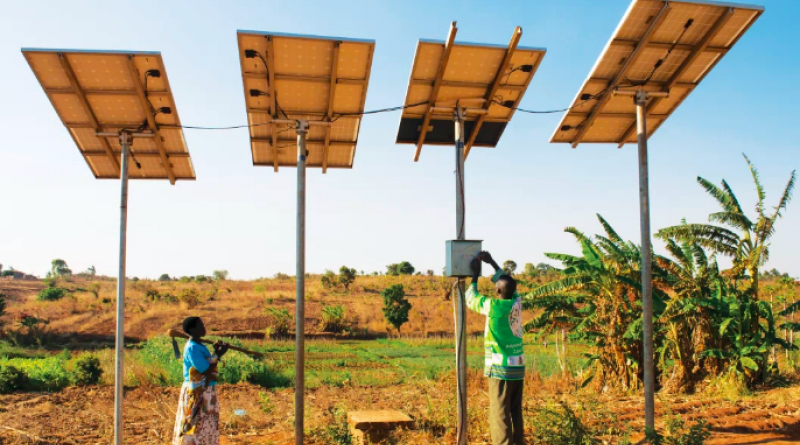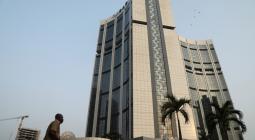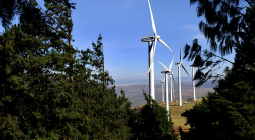Africa’s green renewal gathers pace.

Despite myriad challenges, Africa’s uptake of renewable energy is belatedly moving in the right direction. David Thomas examines how the exciting potential of new technologies is making progress in the face of defective government, policy inertia and risk-averse big business
In the westernmost reaches of the Democratic Republic of Congo, the Congo River’s 96-metre plunge over the thundering cataracts of the Inga Falls drives two decades-old hydro-electric powerplants.
Completed in the 1970s and 80s, the Inga Dams have provided most of the nation’s sporadic electricity supply through decades of political upheaval and violence, even while proving resistant to multiple attempts at sustainable rehabilitation.
Given the state of the facilities – defective turbines and intake blockages have repeatedly decimated generating capacity – hopes years ago turned to a potential 11,000 MW third facility, Inga III, which the government hopes could one day take pride of place in a series of Congo River dams producing some 40,000 MW of power.
Like most large-scale infrastructure projects dreamed up in the Democratic Republic of Congo, things have not gone smoothly. In January, Spanish consortium leader Actividades de Construcción y Servicios withdrew from the $14bn project after failing to agree on how to proceed to construction with partner China Three Gorges. ACS’s withdrawal is just the latest setback to a project marred by accusations of political interference, the 2016 suspension of World Bank funding and the squabbling of commercial partners.
Despite decades of failure, the thwarted potential of the Inga Dams is clear for all to see. A successful project would allow the DRC to harness the renewable potential of one of its greatest natural assets – the mighty Congo, Africa’s second largest river – in the service of transformative national development. Electricity is earmarked for the country’s mining sector, wider population and valuable export to South Africa.
The chaotic history of Inga III offers an elephantine case study in the struggle for renewable energy on the continent – a contest pitting the exciting potential of new technologies against defective government, regulatory and policy inertia and risk-averse big business.
Despite myriad challenges, Africa’s uptake of renewable energy is belatedly moving in the right direction. Given that around 600m citizens across Africa lack power, the need for solutions is urgent. Investment in renewables on the continent is growing fast, according to Bloomberg NEF, which says that 18 countries received more than $10m in clean energy funding in 2018, after 23 did so in 2017. Only 12 countries received that much annually in the prior decade.
The trend is largely driven by solar, with a large pipeline of projects amounting to 1.2 GW expected to come online in 2021 outside South Africa, over double the amount commissioned in 2018. With the right policy framework and investment, Africa could meet a quarter of its indigenous energy needs through renewable sources by 2030, according to the International Renewable Energy Agency.
“Africa’s got a unique endowment of renewable energy resources – it’s probably second to none when it comes to that,” says João Duarte Cunha, manager of renewable energy initiatives at the African Development Bank.
“Some parts of Africa have the best solar resources in the world – mainly the Sahel and Southern Africa. You have geothermal in East Africa, wind in East and West, and hydro in large parts of the continent. So there’s no excuse really – it’s mainly technical and financial issues that stand in the way of deployment.”
Yet despite Africa’s generous renewable resource endowment, many investors are repelled by perceptions of risk, financing shortfalls, the dominant role of national power utilities and a preference in some countries to exploit fossil fuels. The continent with the richest solar resources in the world has to date installed only 5 GW of solar PV, less than 1% of the global total, according to the International Energy Agency. In a bid to ramp up investment, multilateral lenders and academic institutions are launching initiatives to boost private sector and government cooperation.
“I think the future is bright but having said that the rate of penetration is still fairly slow and its really our duty to come in with all sorts of soft financing instruments to push countries and business forward, get scale in the market and see this transition,” says Cunha.
Risky business
In early March, after months of preparation, the European Commission finally launched its long-awaited plan for a “stronger, more ambitious” partnership with Africa based around five foreign policy priorities. Given the European Union’s complex, multifaceted relationship with Africa defined by mass migration, security cooperation and bilateral investment, the top priority – a partnership for green transition and energy access – is a boost to those yearning for a renewable energy revolution in Africa.
The EU says it is already supporting renewable projects in Africa that account for nearly 1500 MW of solar power, over 3000 MW of hydropower and over 500 MW of geothermal power. Yet placing green energy at the very heart of its Africa policy demonstrates a new seriousness of intent. If the strategy is to succeed in crowding in EU capital, it will have to learn from failed multilateral initiatives of the past, argues Malcolm McCulloch, associate professor in engineering science and group leader of the energy and power group at the University of Oxford.
“The reason why a lot of reports just stand up as reports is because they tend to be written by consultants from the West who have a particular view based on what energy systems should look like. They try to impose the same strictures on to [African] countries and are not cognisant of significant political and institutional differences. That’s where you see significant failures. But there are places where they are thinking about the end user and their capabilities.”
Indeed, renewable investment in Africa offers any number of potential pitfalls. Foremost among these is the often-dominant role of state-owned energy utility companies, the ‘offtakers’ that transmit and distribute energy while levying charges on end consumers. The political nature of electricity in Africa – widespread scarcity means that politicians have an electoral interest in controlling prices for their voter base – means that the financial stability of the utilities and an efficient service are rarely guaranteed. While some utilities have improved, only three African countries scored the highest aggregate power sector reform score of between 67 and 100 as ranked by the World Bank in 2019. For renewable energy generation investors looking for reliable offtake partners – for example, operators of wind farms or solar facilities – the lack of certainty can prove fatal to investment decisions.
“What is required is that there’s political will at a country level to address in a serious way reform of the utilities. In many ways its interwoven with the political system which makes it more complicated, but there’s also the need to have an essential amount of resources and technical assistance available to support that reform and transformation of the utility. It’s a nut that has not been cracked yet and something we all highlight as one of the biggest bottlenecks,” says Daniel Schroth, the AfDB’s acting director for renewable energy and energy efficiency.
The need for common understanding with the local utility, especially around tariffs, is just one element of a “derisking” process – others include land rights and foreign exchange stability – that are essential to closing deals. Zambia has successfully undergone this process in its approach to solar power, says McCulloch.
“Zambia has managed to get solar a lot cheaper than many of its neighbours, and the reason behind that was because of their policy engagement in derisking the project substantially. They got the land allocation sorted, the connection sorted and the power purchase agreement sorted. It derisked the project dramatically and the financing costs came down significantly to be able to achieve prices competitive with elsewhere. The policy gap missing is that not many governments are aware of the routes one can or should take to reduce the costs of financing by derisking.”
Neither is derisking a one-off commitment, says Cunha, who helps to run the AFDB’s Sustainable Energy Fund For Africa (SEFA).
“We realised derisking is not enough to support projects to bankability. You need to get more involved in financial structures and provide a degree of risk mitigation. This is why we’re providing concessional capital either through equity contributions which can be subordinated to other senior investors, or other debt instruments that can provide some degree of protection should there be a default or losses associated with projects.”
Yet even where governments lack the institutional capacity or political will to help investors derisk, there is hope that renewables can offer a way to bypass utilities by providing localised services to remote, often rural consumers who were never well served by utilities or the national grid. In much of sub-Saharan Africa, it will not be cost-effective to extend large-scale national grids to remote rural communities. McCulloch leads RELCON (Robust Extra Low Cost Nano Grid), an initiative researching the impact of technology that bridges the gap between small-scale solar – which can power domestic lightning but limits productive economic activity – and larger mini-grids which can be uneconomical for smaller communities. The plan is to allow consumers to pursue economic activities while extending low prices for essential household power.
“The key lesson when you’re going into these areas is you need to understand the actual requirements and the capability of people to make payments and then you need to design a system that is appropriate. With large groups you find they tend to deploy too much capital that cannot be supported by the underlying community, which can create significant losses in the long term,” says McCulloch.
The success of such projects could give rise to new conversations around the role of utilities in the renewable energy chain. While utilities dominate the traditional energy sector because of large capital needs for grid projects and the importance of a stable entity to underwrite risk, the lower start-up costs of many renewable projects mean their role could be eroded. Cunha believes they will still play a role.
“In different countries and contexts you’ll have different solutions but the reality is that there will always be a balance between national utility and private operations operating under concessional agreements covered by a good policy framework. I think that will be the successful recipe because it’s an impossible ask for a utility to electrify entire countries when we know they’re large and sparsely populated. And it’s also impossible to get the private sector to replace state institutions.”
‘Coal is the past’
At the United Nations Climate Action Summit in September in New York, African Development Bank president Akinwumi Adesina confirmed what had long been on the cards – the bank would no longer fund coal projects.
“Coal is the past, and renewable energy is the future. For us at the African Development Bank, we’re getting out of coal,” Adesina told delegates.
While that was unsurprising – the bank’s last coal investment was a supplementary loan in 2015 for a 2009-launched Senegalese coal project – it is not a position which holds unanimous support.
Several African governments believe they should prioritise whatever resources are available to them – whether fossil or renewable – pointing to the continent’s vast electricity deficit and the West’s historic exploitation of fossil fuels. South Africa, the continent’s second largest economy, still gets 80% of its power generation from coal – a recently announced plan for the next decade aims to reduce this by just 21%. Despite the tensions, Cunha is unapologetic about the bank’s stance.
“It is a sensitive question but we need a good dose of realism and to decide whether we want to be on right side of history or the wrong side of history. The reality is that coal is a 19th century technology, and we’re in the 21st century. The technology has come a long way not just in terms of generation but management as well… There is a high risk that certain coal-fired projects become stranded assets over time as renewable energy moves forward and becomes cheaper and more pervasive.”
Schroth says one of the purposes of SEFA is to help African countries manage this transition. In November, the fund announced new priorities including backing green mini grids, boosting green baseloads to support generating capacity, and improving energy efficiency to get more out of green resources. It is hoped that helping to prepare such projects will gradually shift fossil fuel guzzlers away from their addiction by reducing the financial burden of the shift. And as renewables become cheaper, countries will have an economic incentive to complete the process. While challenges remain, Schroth says the progress is encouraging.
“The data is supporting that [renewable] is the direction of travel. The question is the speed by which this is happening. Investments in renewables in Africa are increasing and more and more countries are trying to boost their renewable energy potential.”
8 April 2020
African Business




